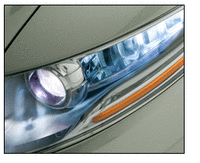New Ford Vehicle Lighting
 |
- Innovative lighting system emphasizes active safety, efficiency, design
- Headlamps on concept vehicle allow drivers to see around corners at night
- Another Ford first uses unique optics package
DEARBORN, Mich., Dec. 28 – Ford Motor Company’s next generation of adaptive lighting takes “smart” headlamps to a new level. Beyond style and function, active safety is at the heart of this innovative system.
With a unique two-part optics package, Ford’s new Adaptive Front Lighting System (AFS), allows drivers to see better around curves in the road than they do with current cornering systems. AFS is among the advanced lighting technologies being unveiled on three Ford Motor Company concept vehicles at the 2006 North American International Auto Show.
The lighting system of one concept vehicle stands out in environmental innovation, featuring solar-powered headlamps and tail lamps. This patented, innovative system captures the sun light during the day and reuses it to power headlights at night.
A third concept vehicle incorporates the latest in lighting technology – head-intensity light emitting diodes (LEDs) in headlights – with a unique style, underscoring the design possibilities of headlights. The look and feel of these headlamps make one think of American cameras of the Fifties.
Meanwhile, AFS helps puts Ford at the forefront in nighttime driving safety, addressing one of the most dangerous driving conditions in the United States. In 2004, more than 20 percent of all fatal accidents occurred between midnight and 6 a.m. – a period that accounts for only 2.4 percent of daily traffic volume, according to the U.S. Federal Department of Transportation.
Even as the 2007 Lincoln Aviator features current cornering front lighting technology, Ford is working on the next generation of adaptive lighting.
Industry Breakthrough
AFS represents an industry breakthrough in front lighting technology. Current cornering – or swivel – systems are made up of one-piece modules that turn as a single unit with the vehicle as it approaches a curve. It works much like a flashlight, lighting the area where the beam is pointed. When the beam is moved, the first area is left dark.
In contrast, AFS incorporates two independent light sources: a high-output halogen projector for the main beam and a secondary row of light emitting diodes (LEDs) that illuminates almost instantaneously, distributes the light beam evenly and consumes less power than conventional lights.
“The way the optics in this system work together has not been seen before in the exterior lighting world,” said Mahendra Dassanayake, staff technical specialist, Optical Electronics. “Besides being a beautifully designed light, the system allows drivers to take corners and curves more safely – and consume less energy while doing so.”
How it Works
The AFS brain, sensing when the vehicle approaches a curve, directs the row of LEDs to switch on sequentially, increasing the amount of additional light around the bend. As the vehicle turns, the LEDs illuminate at a rate and intensity determined by the degree and speed of the turn. Electronic sensors analyze inputs from the steering wheel and the vehicle speed to determine how and when to illuminate the LEDs. The LEDs automatically switch off when the road straightens out. Meanwhile, the main beam continues to illuminate the overall road.
“The result is more light, precisely placed,” said Dassanayake. “We’re not taking light from one spot on the road and moving it to another, as today’s cornering systems do. We’re adding light, making nighttime driving safer.”
Taking LEDs to the Next Level
Ford is among the first automakers to put high-intensity LEDs into production. Today, Ford uses LEDs in brake lights in nearly every current model. With AFS, Ford is showing how LEDs can be used in front lighting systems.
LEDs are the preferred technology for several reasons. While halogen bulbs take a fraction of a second to respond to an electrical input, LEDs respond almost instantly, giving valuable extra warning time to other drivers. LEDs are efficient, saving 200 watts of power and using up to 50 percent less electricity than halogen lights.
With leaner packaging than conventional lights, LEDs also create new possibilities for signature lighting, allowing more flexibility in design.
Lincoln’s Lighting Leadership
Ford Motor Company’s Lincoln division has a rich history as a leader in lighting technology. Form the bullet-shaped dual filament headlights on the 1927 Lincoln to the industry’s first of use of halogen headlamps on the 1979 Lincoln Versailles, Ford holds a long list of lighting patents.
Ford was the first automaker to introduce aerodynamic profile headlamps in the early 1980s, debuting in the Lincoln Mark VII. The switch from the then-standard box head beam provided better airflow around the headlight, improving fuel efficiency. Several years later, Ford became the first North American automaker to offer HID (high intensity discharge) headlamps when the technology were featured on the Lincoln Mark VIII.
Later, Ford introduced the first twin-beam faceted headlamp, placing the low and high beam function in the same cavity as opposed to using four beams. The company also introduced the industry’s first plastic projection lens lamp.


